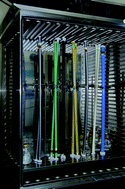In this work, the draft European Standard prEN 15768 “The GC-MS identification of water leachable organic substances from materials in contact with water intended for human consumption” was applied to test 17 different commonly used plastic pipes for domestic plumbing systems for the migration of unexpected substances into drinking water. The tested pipes were made from 8 different plastic materials. Substances detected in the migration waters from the different pipe materials at concentrations exceeding 2 μg l−1 are reported. More than 60% of them could be identified by library search with the NIST mass spectral database. The migrated substances found and identified are discussed concerning their concentration trends with increasing time of testing. A significant number of substances identified were degradation products of antioxidants that are used as additives for the plastic materials. Possible degradation pathways for important antioxidants leading to frequently identified substances like 2,4-di-tert-butylphenol, 3-(3,5-di-tert-butyl-4-hydroxy-phenyl) propanoic acid, 7,9-di-tert-butyl-1-oxaspiro(4,5)deca-6,9-diene-2,8-dione, 3,5-di-tert-butyl-4-hydroxybenzaldehyde, and 2,6-di-tert-butyl-p-benzoquinone are proposed and discussed. As a conclusion, this study showed a good performance of the preliminary standard in practice.

You have access to this article
 Please wait while we load your content...
Something went wrong. Try again?
Please wait while we load your content...
Something went wrong. Try again?


 Please wait while we load your content...
Please wait while we load your content...